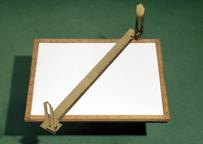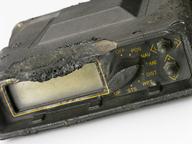









Waywiser by W. Harris and Co., early 19th century
Waywisers were used by the ancient Chinese and Greeks, but became popular in the 18th century as the need for surveying increased with the enclosures. They translate the length travelled by the circumference of the large wheel to distance which can be read off the face. They operate best on smooth surfaces, but will always give longer distances than those measured by geometric methods. This one has two scales: the outer one measures yards and poles, the inner furlongs and miles. Poles were 16½ feet, or a quarter of a chain. A chain was a tenth of a furlong which is an eighth of a mile.
For the purpose of obtaining an approximate measure of distance, simple mechanical devices have been developed of which the best-known in current use is the odometer or mileage indicator usually incorporated with the speedometer of a motor car. Devices of this kind have a long history which can be traced back to the times of classical Greece and Rome and in particular to the writings of Hero of Alexandria and Vitruvious, both of whom described a hodometer consisting of a series of cogged wheels connected to the hub of a carriage wheel and providing an indication of the number of revolutions made by the wheel.
A device based on the same principle and known as the waywiser, perambulator, or surveyor's wheel was much in vogue among surveyors of the second half of the eighteenth century and the early years of the nineteenth century.
The instrument was trundled along the route to be measured and the distance traversed, the number of revolutions multiplied by the circumference of the wheel, was expressed in miles, furlongs, poles and yards by readings of the outer and inner dials mounted just below the handles.




